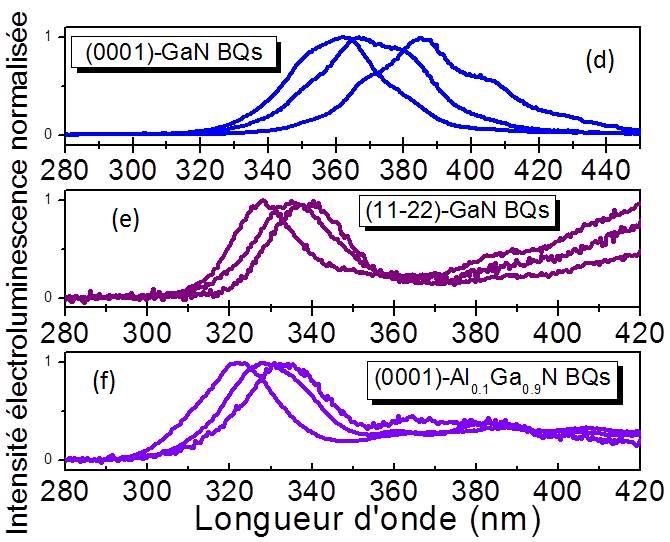The properties of quantum dots (QDs) (3D confinement, discretization of energy levels, Dirac distribution of the density of states, etc.) have been used in the last twenty years to realize many optoelectronic components (lasers, optical amplifiers, single photon sources, etc.). In the III nitride materials and (Al, Ga)N alloys in particular, the use of QDs to confine the carriers is also judicious: indeed, in spite of the high densities of dislocations (around 109 - 1010 cm-2) obtained during hetero-epitaxial growth on sapphire or silicon, their radiative efficiency varies very little between cryogenic temperatures and ambient temperature, whereas it drops sharply in the case of quantum wells. Thus, (Al, Ga)N based light-emitting diodes (LEDs) with quantum wells exhibit limited performances with external quantum efficiencies of the order of a few percent. However, these devices are of great interest because of their emission spectrum, which makes it possible to cover the UV range between 200 nm and 360 nm, and opens up a large field of applications: surface disinfection, air / water purification, dermatology…. In this project, AlyGa1-yN QDs are used as the active area of LEDs made of AlxGa1-xN materials (with x> y) grown on sapphire. The QDs are fabricated by molecular beam epitaxy, via a 2D / 3D growth mode, and grown on (0001) or (11-22) oriented planes. The morphology of the (0001) and (11-22) GaN QDs is shown in Figures (a) and (b): they have heights ranging between 2 nm to 4 nm and lateral dimensions ranging between 20 nm and 40 nm. The wurtzite crystal structure as well as the lattice mismatch between AlyGa1-yN and AlxGa1-xN leads to the presence of an internal electric field (F) along the [0001] axis. The confined quantum Stark effect associated with F leads to (0001) oriented LEDs with red-shifted emission wavelengths (typically above 360 nm) (figure (d)). The fabrication of GaN QDs oriented along the (11-22) plane leads to a strong reduction of F. This remarkable property makes it possible to obtain emissions with shorter wavelengths (figure (e)). The use of Al0.1Ga0.9N to fabricate the QDs (see figure (c)) allows the emission wavelength to be even more shifted towards the UV and to obtain LEDs emitting at 320 nm (figure (f)). This study is supported by the ANR project (ANR-14-CE26-0025-01) “NANOGANUV”.




